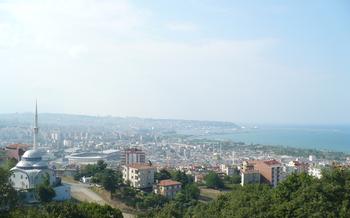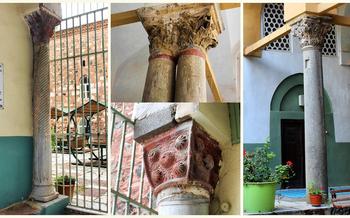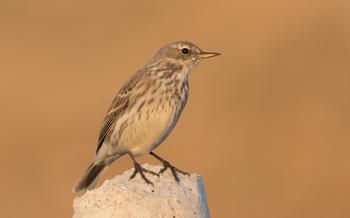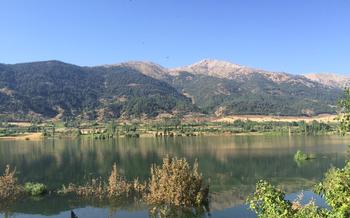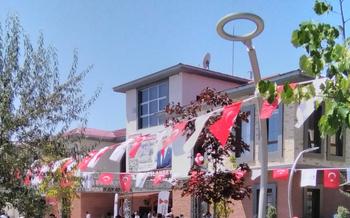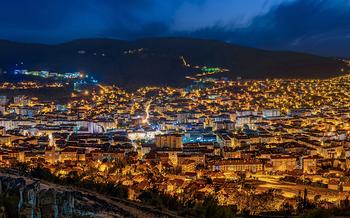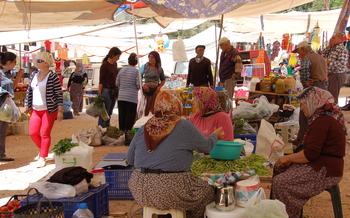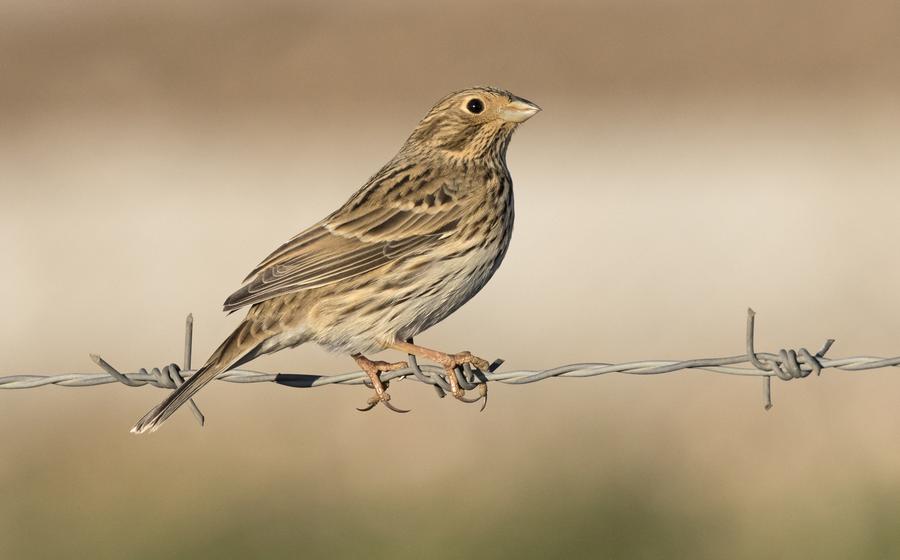
Kahramanmaras Livestock Bazaar
- A Cattle Market with a Long History:
- A Thriving Hub of Trade:
- A Showcase of Local Breeds
- A Cultural Experience
- Tips for Navigating the Market
- A Photographer's Paradise
- A Culinary Adventure
- A Journey into Turkish Craftsmanship
- A Place to Meet the Locals
- A Memorable Experience:
- A photographer's paradise
- A unique cultural experience
- A Great Place to Buy Souvenirs
- Insider Tip
A Cattle Market with a Long History:
The Kahramanmaraş Livestock Bazaar, steeped in rich history, has served as a cornerstone of the region's agricultural economy for centuries. Established in the heart of Kahramanmaraş, this vibrant market has witnessed the ebb and flow of time, evolving into a bustling hub of trade that has shaped the lives of local farmers and traders alike.
Throughout its existence, the market has played a pivotal role in the agricultural landscape of the region. Farmers bring their finest livestock to the market, eager to showcase their prized animals and secure the best prices. Traders from across the country flock to Kahramanmaraş, drawn by the market's reputation for quality and diversity. The lively atmosphere is palpable as buyers and sellers engage in animated negotiations, striking deals that will sustain their livelihoods.
Over the years, the market has undergone numerous transformations, adapting to changing times while preserving its essence. Old-timers, with a twinkle in their eyes, recall the days when the market was a sea of tents, filled with the sounds of haggling and the distinctive aroma of livestock. Today, while modern structures have replaced the tents, the spirit of the market remains unchanged.
Local farmers and traders, with their deep-rooted connection to the market, often share fascinating anecdotes that illuminate its rich history. Stories of shrewd bargains, unexpected friendships, and generational traditions are passed down from father to son, creating a tapestry of memories that bind the community together.
Historical photographs and paintings, capturing the market in its various stages of evolution, offer a glimpse into its vibrant past. These images, displayed with pride in local museums and galleries, serve as a testament to the market's enduring legacy and its vital role in the cultural and economic fabric of the region.
A Thriving Hub of Trade:
The Kahramanmaraş Livestock Bazaar is a bustling hub of trade, where hundreds of animals are bought and sold every day. Farmers from all over the region bring their livestock to the market to sell, while traders from across the country come to purchase animals.
The market is a major economic driver for the region, with an estimated turnover of over $100 million per year.
The types of animals sold at the market include cattle, sheep, goats, and horses. The cattle are mostly used for dairy and meat production, while the sheep and goats are used for meat and wool. The horses are used for transportation and agricultural work.
The market is open every day of the week, but the busiest day is Sunday, when farmers from all over the region come to sell their animals.
The atmosphere at the market is electric, with traders and farmers haggling over prices, animals being herded from one place to another, and the sound of bleating sheep and lowing cattle filling the air.
The Kahramanmaraş Livestock Bazaar is a fascinating place to visit, and it is a great way to learn about the region's agricultural economy and culture.
A Showcase of Local Breeds
The Kahramanmaraş Livestock Bazaar is not just a place to buy and sell animals; it is also a showcase of local breeds. Turkey is home to a wide variety of unique animal breeds, many of which are found nowhere else in the world. The market is a great place to see these breeds up close and learn about their history and characteristics.
Some of the most popular local breeds found at the market include the Anatolian Shepherd Dog, the Turkish Angora goat, and the Kilis goat. The Anatolian Shepherd Dog is a large, powerful dog that is known for its loyalty and protective instincts. The Turkish Angora goat is a long-haired goat that is prized for its soft, silky wool. The Kilis goat is a small, hardy goat that is well-suited to the harsh climate of southeastern Turkey.
The market plays an important role in preserving these local breeds. By providing a place for farmers to buy and sell animals, the market helps to ensure that these breeds continue to be bred and raised. This is important for a number of reasons. First, local breeds are often better adapted to the local climate and environment than imported breeds. Second, local breeds are often more resistant to diseases and pests. Third, local breeds are an important part of Turkey's cultural heritage.
In addition to preserving local breeds, the market also promotes sustainable agriculture. By providing a direct link between farmers and consumers, the market helps to reduce the need for middlemen and transportation, which reduces the environmental impact of the livestock industry. The market also encourages farmers to raise animals in a sustainable way, as they know that consumers are willing to pay a premium for high-quality, locally-raised products.
A Cultural Experience
The Kahramanmaraş Livestock Bazaar is not just a place of commerce but also a vibrant reflection of Turkish culture and traditions. The market is a melting pot of people from different regions of the country, each bringing their unique customs and traditions.
Haggling is an essential part of the market experience. Traders and farmers engage in lively negotiations, often accompanied by good-natured banter. The atmosphere is friendly and welcoming, with traders eager to share stories and insights about their animals and their way of life.
The market is a feast for the senses, with the colorful attire of the traders and farmers adding to the vibrant atmosphere. The air is filled with the sounds of animals, the chatter of traders, and the occasional burst of laughter.
The market is also a place of cultural exchange, as traders from different regions come together to share ideas and learn from each other. This exchange of knowledge and experiences contributes to the preservation and evolution of Turkish traditions and customs.
Tips for Navigating the Market
To make the most of your visit to the Kahramanmaras Livestock Bazaar, here are a few tips to keep in mind:
-
Timing is everything:
-
The market is busiest on Mondays and Fridays, so if you want to avoid the crowds, it's best to visit on another day.
-
The best time to visit is early in the morning, when the animals are fresh and the traders are eager to make a sale.
-
Communication can be a challenge:
-
Not all of the traders at the market speak English, so it's helpful to have a translator or a phrasebook with you.
-
Even if you don't speak Turkish, you can still communicate through gestures and body language.
-
Bargaining is expected:
-
Don't be afraid to bargain with the traders. It's all part of the fun and it's often possible to get a good deal.
-
Be polite and respectful, and don't be afraid to walk away if you're not happy with the price.
-
Safety first:
-
The market can be crowded and chaotic, so it's important to be aware of your surroundings and take precautions to avoid getting lost or overwhelmed.
- Keep your valuables close at hand and be wary of pickpockets.
A Photographer's Paradise
The Kahramanmaras Livestock Bazaar is a photographer's paradise. The vibrant colors and textures of the market, the candid moments of traders and animals, and the overall atmosphere create a unique and captivating scene.
To capture the essence of the market, it's essential to use the right camera settings and composition. A wide-angle lens is ideal for capturing the bustling crowds and the vast expanse of the market. A fast shutter speed is necessary to freeze the movement of the animals and traders.
Look for interesting compositions that tell a story. The market is full of colorful characters and unique moments, so keep your eyes peeled for opportunities to capture these. Don't be afraid to get close to your subjects and experiment with different angles.
The best time to visit the market for photography is early in the morning when the light is soft and golden. This is when the animals are most active, and the market is at its busiest. However, the market is also worth visiting at other times of the day, as the light changes and creates different moods and atmospheres.
Whether you're a professional photographer or just an enthusiast, the Kahramanmaras Livestock Bazaar is a great place to capture some stunning images.
A Culinary Adventure
The Kahramanmaraş Livestock Bazaar is not just a place to buy and sell animals; it's also a culinary paradise, where visitors can sample some of the region's most delicious delicacies. From traditional Turkish dishes to unique regional specialties, the market is a foodie's heaven.
Among the must-try dishes at the market is "maraş tarhanası," a hearty soup made with fermented wheat, yogurt, and vegetables. Another local specialty is "sıkma," a type of fried dough that is often served with honey or molasses. For those with a sweet tooth, there are plenty of sweet treats to choose from, such as "cevizli sucuk," a sausage-shaped candy made with walnuts and grape molasses, and "tahinli pide," a flatbread filled with tahini and honey.
For those who want to cook their own meals, the market is a great place to buy fresh ingredients. There are stalls selling everything from fruits and vegetables to spices and herbs. You can also find a variety of local cheeses, yogurts, and other dairy products.
Whether you're looking for a quick bite to eat or a full-blown feast, the Kahramanmaraş Livestock Bazaar is the place to go. With its wide variety of culinary delights, it's sure to satisfy even the most discerning palate.
Here are some recipes for some of the dishes that can be found at the market:
-
Maraş Tarhanası:
-
Ingredients:
- 1 cup fermented wheat
- 1 cup yogurt
- 1 onion, chopped
- 2 cloves garlic, minced
- 1 tablespoon tomato paste
- 1 teaspoon red pepper flakes
- 1 teaspoon salt
- 2 cups water
-
Instructions: In a large pot, bring the water to a boil. Add the wheat, yogurt, onion, garlic, tomato paste, red pepper flakes, and salt. Reduce the heat to low and simmer for 30 minutes, or until the wheat is cooked through. Serve hot.
-
Sıkma:
-
Ingredients:
- 2 cups flour
- 1 teaspoon salt
- 1 egg, beaten
- 1 cup water
- Oil for frying
- Instructions: In a large bowl, combine the flour, salt, egg, and water. Knead the dough until it is smooth and elastic. Divide the dough into small balls. Roll out each ball into a thin rope. Heat the oil in a large pot or deep fryer. Fry the ropes of dough until they are golden brown. Drain on paper towels and serve hot.
A Journey into Turkish Craftsmanship
The Kahramanmaraş Livestock Bazaar is not just a place to buy and sell animals; it's also a hub for traditional Turkish crafts and textiles. Here, you'll find artisans selling handmade carpets, kilims, pottery, jewelry, and more. These crafts are often made using traditional techniques that have been passed down from generation to generation.
One of the most popular crafts in the region is carpet weaving. Kahramanmaraş is known for its beautiful, hand-woven carpets, which are often made with wool or goat hair. These carpets are not only durable but also works of art, with intricate designs and vibrant colors.
Another popular craft is pottery. The region is home to several villages where potters create beautiful, hand-painted ceramics. These ceramics are often used for everyday purposes, such as cooking and serving food, but they can also be decorative items.
If you're looking for a unique souvenir from your trip to Turkey, be sure to visit the Kahramanmaraş Livestock Bazaar. Here, you'll find a wide variety of handmade crafts and textiles that are sure to impress your friends and family.
When shopping for handicrafts at the market, be sure to bargain with the vendors. This is a common practice in Turkey, and it's a great way to get a good price on your purchase. Just be sure to be respectful and friendly, and don't be afraid to walk away if you don't like the price.
A Place to Meet the Locals
The Kahramanmaraş Livestock Bazaar is not just a place to buy and sell animals; it's also a place to meet the locals and learn about their way of life. The market is a microcosm of Turkish society, with people from all walks of life coming together to trade, socialize, and share stories.
One of the best ways to experience the market is to simply wander around and observe the people. You'll see farmers in their traditional clothing, traders haggling over prices, and children running around playing. The market is a great place to people-watch and learn about the local culture.
If you're feeling brave, you can also try to strike up a conversation with some of the locals. Most people are friendly and welcoming, and they're happy to share stories about their lives. You might learn about the history of the market, the different breeds of animals that are sold, or the local customs and traditions.
The Kahramanmaraş Livestock Bazaar is a great place to meet the locals and learn about their way of life. It's a vibrant and colorful place, full of interesting people and stories. So if you're looking for a truly Turkish experience, be sure to visit the market.
A Memorable Experience:
Kahramanmaraş Livestock Bazaar is not just a place to buy and sell animals; it's an immersive experience that will leave a lasting impression on visitors. The sights, sounds, and smells of the market are unlike anything you'll find anywhere else.
Visitors can expect to be captivated by the vibrant atmosphere and the bustling crowds of traders and farmers. The air is filled with the sounds of animals braying, bleating, and neighing, and the smell of hay and manure is pungent.
The market is also a great place to learn about Turkish culture and traditions. Visitors can observe the colorful attire of the traders and farmers, and they can witness the lively bargaining that takes place between buyers and sellers.
For many visitors, the highlight of the market is the opportunity to interact with the animals. Visitors can pet the animals, feed them, and even take pictures with them.
If you're looking for a unique and unforgettable experience, Kahramanmaraş Livestock Bazaar is the place to go. Whether you're an animal lover, a photographer, or simply someone who wants to experience a different culture, you're sure to have a memorable time at this bustling marketplace.
A photographer's paradise
The Kahramanmaraş Livestock Bazaar is a photographer's paradise. The vibrant colors of the animals, the bustling atmosphere of the market, and the unique characters of the traders and farmers all make for great photo opportunities.
The best time to visit the market for photography is early in the morning, when the light is soft and golden. This is when the animals are most active and the traders are setting up their stalls. Be sure to bring a wide-angle lens to capture the full scope of the market, as well as a telephoto lens to zoom in on the details.
Don't be afraid to get up close to the animals and the people. The traders are usually happy to pose for photos, and the animals are often curious about visitors. Just be sure to be respectful and avoid getting in their way.
If you're looking for a unique and memorable photo experience, the Kahramanmaraş Livestock Bazaar is the place to go. Just be sure to come prepared with your camera and a sense of adventure.
A unique cultural experience
The Kahramanmaras Livestock Bazaar is not just a place to buy and sell animals; it is also a vibrant cultural hub where visitors can immerse themselves in Turkish traditions and customs. The market is a reflection of the region's rich history and heritage, and it offers a unique opportunity to interact with locals and learn about their way of life.
As you wander through the market, you'll be struck by the colorful attire of the traders and farmers. The men often wear traditional şalvar (baggy pants) and a gömlek (shirt), while the women wear brightly colored headscarves and long dresses. The air is filled with the sound of haggling and the smell of freshly grilled kebabs.
The market is also a great place to sample local delicacies. You can find everything from gözleme (a type of flatbread filled with cheese, meat, or vegetables) to kebabs to künefe (a sweet pastry made with shredded filo dough and cheese).
If you're looking for a truly unique and immersive cultural experience, be sure to visit the Kahramanmaras Livestock Bazaar. You won't be disappointed.
A Great Place to Buy Souvenirs
The Kahramanmaraş Livestock Bazaar is a treasure trove of unique and memorable souvenirs. From handmade crafts and textiles to traditional Turkish delicacies, there's something for everyone at this vibrant market.
One of the best things about shopping at the bazaar is the opportunity to haggle with the vendors. Don't be afraid to bargain for a good price, as this is all part of the fun. Just be sure to do your research beforehand so that you know what a fair price is for the item you're interested in.
If you're looking for a truly unique souvenir, be sure to check out the handmade crafts and textiles. These items are often made by local artisans using traditional techniques that have been passed down for generations. You'll find everything from hand-woven rugs and kilims to intricate pottery and jewelry.
And of course, no visit to the Kahramanmaraş Livestock Bazaar would be complete without trying some of the delicious food that's available. From traditional Turkish kebabs to freshly baked bread and gözleme, there's something to satisfy every taste bud.
Insider Tip: Be sure to visit the market early in the morning to get the best selection of goods. And don't forget to bring your camera to capture all the vibrant colors and textures of this unique market.
Insider Tip
For those seeking a unique experience, venture into the hidden gem of the Kahramanmaraş Livestock Bazaar, where locals gather for a traditional breakfast at the small, unassuming cafes nestled within the market. Indulge in a hearty breakfast of gözleme, a savory pastry filled with cheese, meat, or vegetables, accompanied by a refreshing glass of traditional Turkish tea. This is a fantastic way to immerse yourself in the local culture and connect with the friendly locals who frequent these cafes. Don't miss this opportunity to experience the true essence of the market and create lasting memories.
